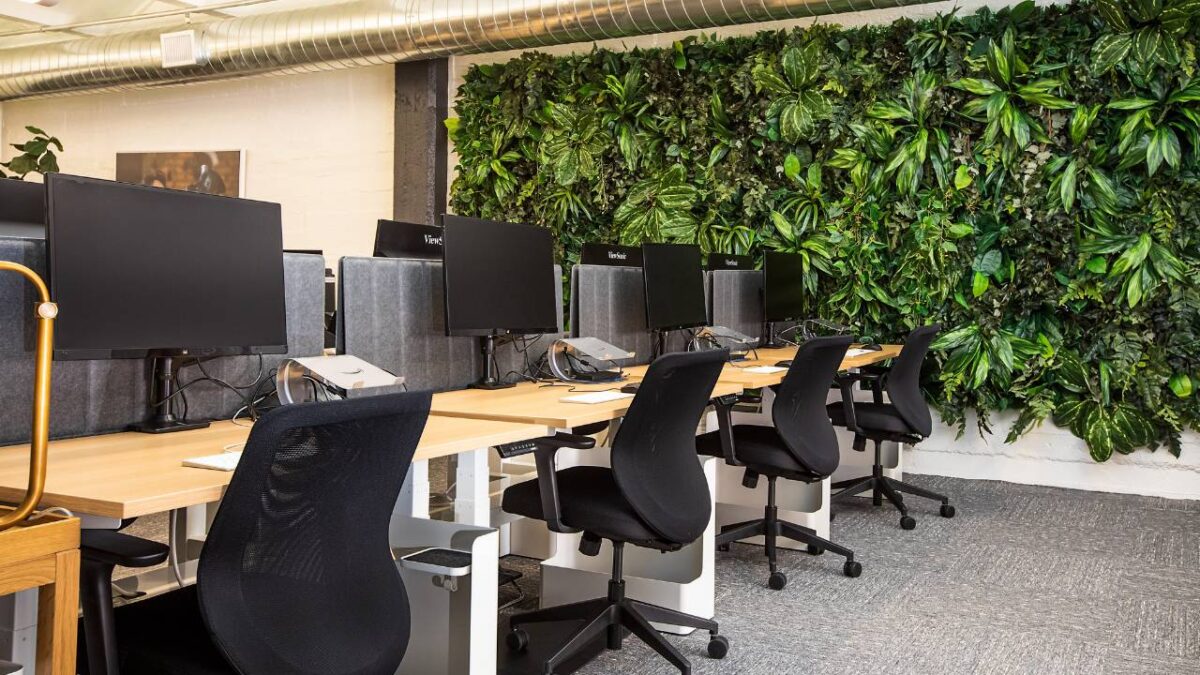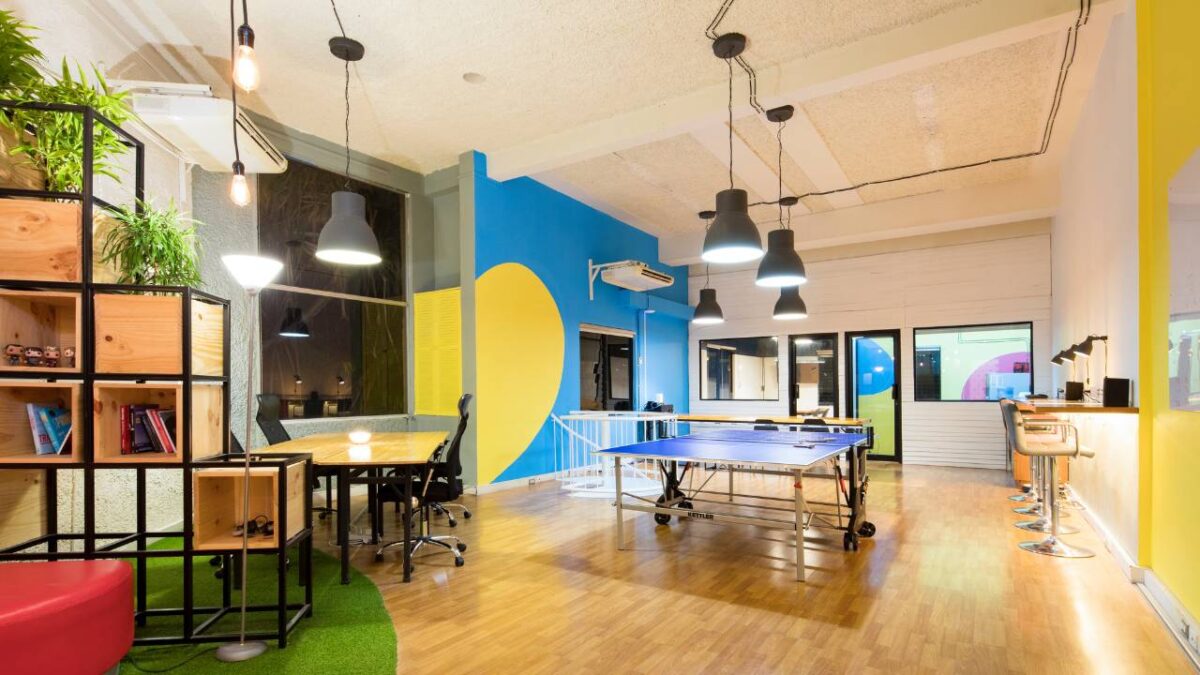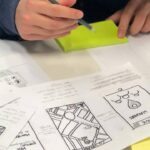In the fast-paced corporate world, being productive and efficient is crucial to success. Your workspace can play a significant role in elevating this efficiency and ensuring a smoother workflow for you and your team. This is where innovative workspace design comes in, offering numerous benefits that can enhance your overall work experience.
Understanding Workspace Design
When it comes to enhancing productivity, workspace design plays a crucial role. A well-designed office sets the stage for creative and efficient work, making it essential to understand the key principles behind excellent workspace design.
Firstly, consider the aesthetics of your workspace. A visually appealing environment can boost your mood and, therefore, your productivity. Incorporate elements of interior design, such as lighting, colour schemes, and interesting textures, to create an inviting atmosphere. Be mindful of the balance between aesthetics and practicality, as an overly stylised workspace may become distracting.
Another fundamental aspect of workspace design is flexibility. Modern work often demands a high degree of adaptability, so designing an office that can accommodate a variety of tasks is important. For example, consider incorporating modular furniture that can be reconfigured or creating distinct zones for different types of work. This way, you can cater to diverse working preferences and needs.
Well-planned office design must incorporate ergonomics. As you spend a significant portion of your day at work, it’s essential to prioritise your physical comfort and well-being. Invest in ergonomic office furniture like adjustable chairs and standing desks that support a proper working posture. In addition, ensure that your workspace has adequate ventilation, air quality, and temperature control.
Lastly, don’t underestimate the power of green spaces within your office. Introduce plants and natural elements into your workspace design for a positive impact on well-being and productivity. You might opt for living walls, potted plants, or even designated outdoor areas for work and relaxation.
The Shift Towards Innovative Workspaces
In today’s fast-paced business environment, you need to be able to adapt to new challenges quickly. One way to boost your flexibility is by embracing workspace innovation. Traditional offices often restrict your potential, but innovative workspaces encourage creativity and productivity.
Flexible workspaces have become a popular solution for many businesses. These spaces give you the freedom to choose your own working environment, whether it’s a hot desk, a coworking space, or even a sofa in a communal area. The freedom to move and collaborate helps you build connections with your colleagues and exchange ideas more efficiently, ultimately leading to innovative breakthroughs.
Moreover, coworking spaces like WeWork provide a range of facilities promoting comfort and collaboration. They often feature various work environments, sophisticated meeting rooms, and sometimes even leisure zones. Within such spaces, you can connect with like-minded individuals and benefit from the exchange of knowledge while expanding your professional network.
The Role of Nature in Workplace Efficiency

Incorporating nature into your workspace design can significantly improve workplace efficiency. Exposure to natural elements such as natural light and plants can have several positive effects on your overall well-being and productivity.
Natural light is essential for your body’s circadian rhythm, affecting your sleep-wake cycle. Research has shown that exposure to natural light can improve alertness and focus, helping you make the most of your day. To maximise the benefits of natural light, consider positioning your workspace near windows or using skylights and glass walls to allow light to flow into the space.
Introducing plants into your office environment not only adds a touch of greenery but can also improve air quality. Plants are known to absorb pollutants, reducing levels of carbon dioxide and volatile organic compounds. This can lead to improved cognitive performance and reduced levels of stress, ultimately boosting workplace efficiency.
In addition to these fundamental elements, incorporating nature-inspired design features into your workspace, such as wood furnishings and calming colours, can lead to better mental health and morale. Aesthetically pleasing environments have been found to promote relaxation and concentration, which in turn can increase productivity.
Design Elements that Boost Productivity
When considering innovative workspace design, it’s essential to incorporate elements that promote productivity and efficiency. Here are a few key factors to keep in mind as you create your ideal workspace.
Natural Lighting: Letting in natural light can significantly impact your productivity levels. Bright, natural light not only reduces eye strain and improves mood but it also helps regulate your circadian rhythm, ensuring you maintain high energy levels throughout the day.
Colour Schemes: Choosing the right colour scheme for your workspace can have a substantial effect on your overall productivity. Cool colours such as blues and greens tend to promote focus and reduce stress, while warm colours like reds and yellows can stimulate creativity and energy. Consider the nature of your work when selecting a colour scheme to optimise your workspace.
Ergonomics: Ensuring your workspace is ergonomically designed can greatly contribute to your comfort and efficiency. Invest in adjustable chairs, desks, or standing desk converters to maintain proper posture and reduce muscle fatigue. Additionally, position your computer monitor at eye level to minimise neck strain.
Flexible Layouts: An adaptable workspace fosters collaboration and allows you to easily switch between individual tasks and group work. Arrange your workspace so that you have designated areas for focused work, team meetings, and relaxation or brainstorming. This way, you can transition seamlessly between different work modes while maintaining efficiency.
Organisation and Storage: A clutter-free environment helps you stay focused and efficient throughout the day. Implement storage solutions such as shelves or filing cabinets to ensure all your work materials have a dedicated place. By keeping your workspace tidy, you can reduce distractions and improve your overall workflow.
The Importance of Flexibility and Versatility
In today’s fast-paced and ever-evolving professional environment, it’s essential to have a workspace that meets various demands. With flexibility being a central feature, you’ll discover numerous benefits in terms of productivity and employee satisfaction.
Consider the rise in remote work and activity-based working; they require an adaptable workspace to accommodate individual working styles and preferences. A versatile work environment allows you and your team to switch between focused, individual work and collaborative tasks effortlessly. This adaptability fosters a more engaged and efficient workforce.
Breakout spaces play a vital role in promoting flexibility. These areas can be used for informal meetings, brainstorming sessions, or a quick breather away from the desk. They enable employees to feel more relaxed and comfortable, thus enhancing creativity and innovation.
To embrace flexibility in your workspace, incorporate the following features:
- Adjustable furniture: Choosing furniture that can be easily rearranged or repurposed allows you to adapt quickly to various tasks and requirements.
- Technology integration: Providing the necessary technology, such as high-speed Wi-Fi, suitable workstations, and collaboration tools, enables efficient remote work and communication.
- Private and open areas: Creating a balance between private zones for focused work and open, collaborative spaces encourages activity-based working and caters to all working styles.
The Impact of Workspace Design on Employee Well-being

When designing your workspace, it’s essential to consider the well-being of your employees. A well-designed workspace can significantly impact their health, happiness, and overall job satisfaction. In this section, we’ll explore some of the benefits of innovative workspace design on employee well-being.
One aspect to consider is natural light. Ensuring your workspace has plenty of windows and access to daylight can boost the mood and energy levels of your employees. Exposure to natural light has been linked to improved mental health and increased productivity.
Creating an environment that encourages movement throughout the day is vital for employee well-being. Integrating standing desks, walking meetings, or flexible seating arrangements can help reduce sedentary behaviour and promote physical health.
Incorporating greenery into the workspace is another effective strategy for enhancing well-being. Studies have shown that plants improve air quality, reduce stress, and boost creativity. By adding a touch of nature to your workspace, you’ll create a more inviting and healthy environment for your employees.
Additionally, consider providing dedicated spaces for relaxation and quiet work. These spaces allow employees to recharge, reflect and concentrate on their tasks without interruption. By offering these areas, you’re supporting their mental well-being and encouraging a positive work-life balance.
Lastly, think about the ergonomics of your workspace design. Providing adjustable chairs, keyboard trays, and monitor stands can help employees maintain proper posture and prevent workplace injuries related to poor ergonomics.
Creating Spaces for Collaboration and Individual Tasks
When designing your workspace, it’s important to create areas that cater to both collaboration and individual tasks. Striking the right balance between these spaces can help improve communication, productivity, and overall efficiency.
For collaborative spaces, consider the needs of your team members. The environments should be flexible, allowing for impromptu meetings and brainstorming sessions. Open spaces with comfortable seating, mobile whiteboards and accessible technology can encourage employees to share ideas and work together. Remember, good communication is key to effective teamwork, so nurture it by providing spaces that promote interaction and collaboration.
At the same time, don’t forget the importance of individual work. Create designated private offices or quiet zones where employees can focus on their tasks, free from distractions. By providing a comfortable and functional space for individuals, you can significantly enhance their productivity and ability to concentrate on their work.
Here are some tips for designing these spaces:
- Implement a mix of open-plan and enclosed areas to accommodate various work styles
- Use adjustable furniture and temporary walls for flexibility and adaptability
- Incorporate natural light and plants to create a welcoming and calming atmosphere
How Workspace Design Affects Job Satisfaction and Engagement
As you step into your office, how you feel about the workspace plays a crucial role in enhancing job satisfaction and employee engagement. A well-designed workplace can significantly foster a sense of belonging, trust, and commitment to your work.
Firstly, let’s discuss how your surroundings impact your productivity. Bright colours, natural light, and ergonomic furniture contribute to creating a pleasant and comfortable environment. When you feel physically at ease in your workspace, you are likely to be more focused, alert and engaged in your tasks.
Next, consider the layout of your office. An open-plan design is an excellent approach to facilitating collaboration and communication within your team. When you can easily exchange ideas and seek feedback, you feel more connected to your colleagues and the work you do. This fosters a sense of belonging and helps to build trust within the team.
Another important aspect of workspace design is the availability of quiet areas or designated zones to concentrate on individual tasks. By creating spaces that cater to different work styles, your office promotes a more efficient and personalised approach to work. This, in turn, enhances job satisfaction as employees feel more respected and valued.
Moreover, incorporating elements of biophilia in your workspace can positively affect your mental well-being. Plants, natural materials, and access to outdoor spaces help to reduce stress and promote relaxation. When you feel more at ease and connected to nature, your creativity and overall happiness at work improve.
The Influence of Workspace Design on Workplace Productivity

As you consider your workspace design, it’s important to recognise how it can impact overall workplace productivity. The physical work environment plays a significant role in keeping your employees motivated, engaged and efficient. Let’s explore a few ways that innovative workspace designs can boost productivity.
First, consider the layout of your workspace. Open floor plans are often praised for promoting collaboration, but they can also contribute to distractions. Providing a balance of open areas and private spaces allows your team to enjoy the benefits of collaboration while also having access to quieter spaces to focus on individual tasks. Flexible spaces that can be adapted to suit different purposes are also essential, allowing your employees to tailor their environment as needed.
Lighting is another vital element in workspace design. Natural light has been linked to improved focus, creativity, and overall mood. Where possible, design your workspace to maximise the amount of natural light that floods the space. If this isn’t an option, choose well-designed artificial lighting options that cater to different needs and preferences, like adjustable floor lamps or desk lamps.
Integrating elements of nature into your workspace can greatly influence workplace productivity. Incorporating natural features such as plants, green walls or water features can reduce stress levels, improve air quality, and create a more pleasant atmosphere. These biophilic designs not only make your workspace more aesthetically appealing but also contribute to higher levels of productivity.
Ergonomics should be a key consideration in your workspace design. Comfortable furniture and well-designed workstations can have a dramatic effect on reducing fatigue, improving posture, and increasing efficiency. It’s important to invest in quality ergonomic equipment, such as adjustable chairs, sit-stand desks, and monitor arms, that help prevent strain and discomfort.
Finally, fostering a sense of community through workspace design can also positively affect workplace productivity. Integrating spaces for social interaction, like break rooms or common areas, encourages team members to connect informally and build relationships. These bonds, in turn, lead to improved morale, teamwork and overall happiness.
Leveraging Technology and Design for an Efficient Workspace
In today’s fast-paced work environment, it is essential to leverage technology and innovative design to create an efficient workspace. By incorporating cutting-edge tools and thoughtful design principles, you can boost productivity, create a more welcoming atmosphere, and improve the overall work experience.
Consider incorporating smart devices and IoT-enabled technologies in your workspace design. For instance, incorporating digital whiteboards and virtual collaboration tools can facilitate seamless communication and collaboration among team members. From scheduling to project management, there’s an array of software and applications available to help streamline your daily tasks and keep your team organised.
Regarding the physical layout of your workspace, be mindful of its impact on employee well-being and productivity. It is vital to strike a balance between open and private spaces, allowing for both collaboration and focused individual work. Natural light and greenery positively influence mood and stimulate creativity, so do your best to provide employees with ample access to windows and plants.
To keep up with the ever-evolving work landscape, consider adopting agile design principles; spaces that can be easily reconfigured or repurposed as needed are invaluable. Modular furniture and adaptable workstations make it simple to transition between different team activities, ensuring that everyone has the space they need to complete their tasks efficiently.
Lastly, research indicates that creating a space where employees have the freedom to choose their preferred work setting, such as standing desks or ergonomic chairs, increases job satisfaction and productivity. Recognising this, consider incorporating diverse work areas such as quiet zones, collaborative hubs, and breakout spaces designed to facilitate focus, creativity, and collaboration.
Conclusion
You might have gained valuable insights into the key aspects of workspace design that elevate efficiency and productivity. By incorporating these elements in your office space, you can expect a positive transformation in work culture and a sense of camaraderie among employees.
Embrace the essence of an efficient and innovative workspace, as it brings about the best in everyone and ensures you are well on your way to achieving your goals. Remember, your workspace is a reflection of your organisation’s values, so make sure it fosters an atmosphere conducive to success!






